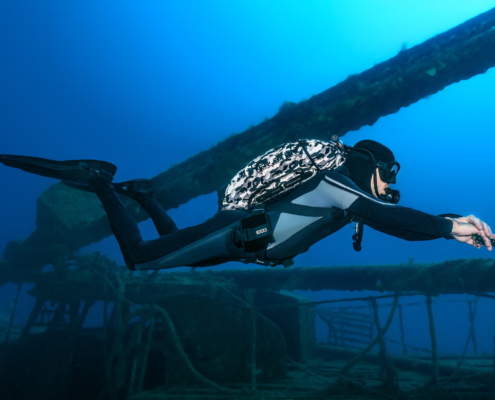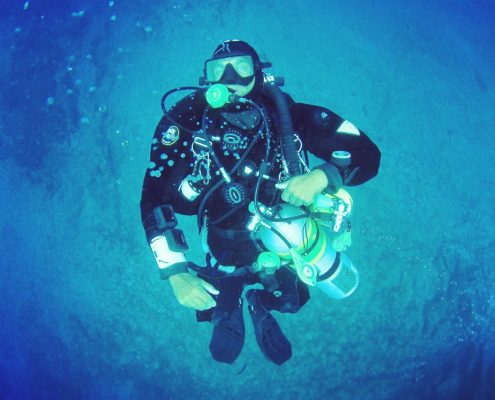What is Accelerated Decompression?
Clearing up some mystery
You may have heard some divers discussing topics which sound altogether unfamiliar… Like most things in life, the more enthusiastic you become about diving, the more you are going to learn about it.
Disclaimer: This post attempts to answer some questions and provide basic background knowledge but is not a replacement for proper training from a qualified professional.
For many people, diving to a maximum depth of 30 metres with a single tank and a limited time to explore is just fine. There is so much to see and do here that you can spend a lifetime diving within these limits and enjoy every minute of it.
Others, however, seek extra challenges… Many divers want to keep learning; keep exploring; keep pushing themselves and keep pushing the limits of what they can do underwater. This is the appeal of Technical diving.
Essentially Technical diving is simply going beyond the limits of Recreational Scuba Diving, usually with respect to depth and bottom time.
Yes… Tec divers go deeper for longer!
Diving on Air
Any qualified diver will know that the Air we breath while diving is at a higher pressure than what we are used to above the surface. This results in our bodies absorbing (or ‘on-gassing’) some of the inert Nitrogen. To safely return to the surface we must 1) limit the amount of Nitrogen we absorb by monitoring and staying within our No-Decompression Limit, and 2) ascend to the surface slowly. A slow ascent allows sufficient time for the Nitrogen to come back out of solution and return to our lungs – via the circulatory system – to be exhaled (‘off-gassed’).
No-Decompression Diving
‘Recreational diving’ is generally considered to be diving within the ‘No-Decompression limit’. What this means is that we limit the time we spend at depth in order to ensure that we do not on-gas too much inert gas (Nitrogen). If we stay within our no-decompression limit then – theoretically – it should be safe for us to make a direct ascent to the surface, albeit in a slow and controlled manner, without the need to make stops on the way.
(Note: the name ‘No-Decompression’ can be sightly misleading. All dives involve some amount of decompression but by staying within our no-decompression (no-deco) limit then we should not need to make staged ‘Decompression stops’ and for this reason no-deco diving is often referred to as ‘no-stop’ diving).
Decompression Diving
If we exceed the No-Decompression limit then we on-gas too much Nitrogen, meaning that we can no longer simply ascend to the surface in a slow, controlled manner to end the dive. With an elevated pressure of Nitrogen absorbed in the body, it becomes necessary to make an especially slow ascent – much slower than we learn to do in Recreational Diving Courses. Not only does the ascent need to be very slow, but it is preferable to change the rate of our ascent as we go, ascending relatively quickly from deep water and gradually slowing down the ascent as we get closer and closer to the surface.
Since such a long and slow (continuous) ascent would be very difficult – requiring constant concentration and presenting too many opportunities for error – instead we break the ascent into 3 metre (10-foot) increments. We ascent to the depth where the first stop is required and then wait a moment to off-gas. Then we ascend 3 metres to the next stop depth and wait a little longer. As we ascend in 3 metre increments, the time we wait at each stops gets progressively longer and longer. This effectively mimics the ideal curve of an ascent as described previously, whilst being relatively easy to control and monitor.
The basics of Decompression
One reason why you see Tec Divers carrying multiple cylinders is simply because with so much time in the water and at such great depths, the gas requirements for the dive go well beyond what can be expected from a single tank. Another reason is that at different stages of the dive the diver may choose to breath different gas mixes.
For now let’s imagine that the diver is diving to a maximum depth of 50 metres and is breathing standard Air throughout the exploration portion of the dive. Of course, they could continue to breathe the Air throughout the ascent, but is there a quicker way?
The rate at which we on- and off-gas Nitrogen is effectively determined by one factor: the difference between the pressure of Nitrogen in our lungs and the pressure (tension) of Nitrogen in our blood. The bigger the gap (or gradient), the faster the Nitrogen will move from one medium to the other. This explains why we can stay a very long time in shallow water but less and less time as we venture deeper.
During the ascent we will reach a point where the Nitrogen tension in our bodies exceeds the pressure of the Nitrogen in our lungs, at which stage the process is reversed and we start off-gassing (decompressing).

Image courtesy of njscuba.net: Illustration purposes only – NOT to be used for actual dive planning
Accelerated Decompression
If, during the ascent, we switch to a Nitrox mix (a gas mix with less Nitrogen) then we are able to lower the pressure of Nitrogen in our lungs without changing our depth or reducing the overall pressure around us. This has the affect of increasing the gradient further between the pressure of nitrogen in our lungs and the tension in our blood, thereby increasing the rate of off-gassing. This is called Accelerated Decompression. This can be seen in the table above, where the blue line indicates the typical decompression obligation if the diver stays on the same gas he used throughout the bottom-portion of the dive, compared to the red line where the diver switches to a rich Nitrox mix to speed up decompression.
Accelerated decompression is the starting point when it comes to transitioning to Technical diving. Learning the equipment requirements and becoming familiar with new procedures is, for many, all part of the appeal.
Still awake?
If you are interested to read this much, then perhaps you’d be interested in learning more about Technical diving. Get in touch to schedule your technical diver training: info@aqua-marina.com
See you soon







